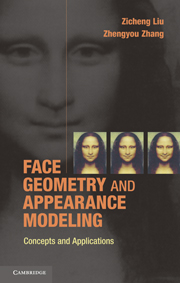6 - Appearance modeling
from PART II - FACE MODELING
Published online by Cambridge University Press: 01 June 2011
Summary
In addition to its shape, the image of an object also depends on its surface reflectance properties and the lighting environment. In this chapter, we describe techniques to recover the reflectance properties and lighting environment. These techniques usually assume that the geometry of the object is known.
Reflectometry
Refectometry is the measurement of a material's reflectance property which can be represented as a four-dimensional Bidirectional Reflectance Distribution function, or BRDF. A device for measuring BRDFs is called a gonioreflectometer. One such device was designed by Murray-Coleman and Smith [154]. It consists of a photometer that moves relative to the material to be measured. The material moves relative to a light source. All the motions are controlled by a computer.
A simpler device, called imaging gonioreflectometer, was developed at Lawrence Berkeley Laboratory [229]. It uses a fish-eye lens camera and a half-silvered hemisphere to replace the mechanically controlled photometer. In this way, it only needs one mechanical driver that pivots the light source. This device is much easier to build, and the capturing is much faster than the one built by Murray-Coleman and Smith [154]. Since the captured data are usually noisy and incomplete, Ward [229] proposed a parametric function, called an anisotropic Gaussian model, to represent the BRDF. The parametric function consists of four parameters, which are determined by fitting the parametric function to the data captured by the imaging gonioreflectometer.
- Type
- Chapter
- Information
- Face Geometry and Appearance ModelingConcepts and Applications, pp. 86 - 110Publisher: Cambridge University PressPrint publication year: 2011



